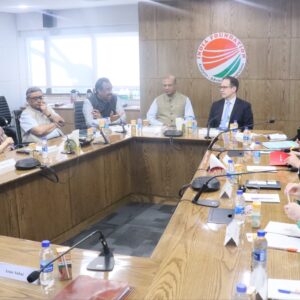~ By Varsha Gupta
“The country’s first priority is generating employment for the youth of the country”, said Prime Minister Modi on 15 July 2015, at the launch of the “Skill India Mission”. The statement sums up the need of the hour, when almost 65 per cent of Indian population is below 35 years of age, which constitutes the potential workforce. The situation demands immediate action from the government to utilise this manpower to propel the economy to greater heights and not allow them to languish aimlessly, making them potential recruits for anti-national outfits. Skill India Mission, therefore, seeks to create “structures and mechanisms to nurture youngsters, enabling them to find employment” and to live a life of dignity.
The ambitious Skill Development Mission primarily aims to impart skills to more than 40 crore young people by the year 2022. It will not only make the youth capable of earning the bread and butter for their family but would also instil in them with a sense of self-confidence and respect, and would enthuse fresh energy into the country. The vision statement of the Mission quite aptly summarises its daunting aim which is “to create an ecosystem of empowerment by skilling on a large scale and speed with high standards so as to ensure sustainable livelihoods and to place India in the comity of front ranking entrepreneurial and innovative nations”.
Schemes under the mission
The Skill India Mission, launched under the leadership of Rajiv Pratap Rudy, Union minister of State (Independent Charge) for Skill Development & Entrepreneurship, introduces two major schemes.
The Pradhan Mantri Kaushal Vikas Yojana (PMKVY) is the flagship scheme that will be implemented through the National Skill Development Corporation (NSDC). It is the outcome-based skill training scheme which seeks to train around 24 lakh youths to enable them to earn their livelihood. Under this scheme, the trainees would be trained, assessed and duly certified as per international standards through various government approved industrial training centres, polytechnic institutes, schools and colleges. The successful implementation of this scheme would lead to the generation of new skilled workforce that would neutralise the excessive demand for manpower in the key sectors over the next five to seven years.
The second key scheme, the Skill Loan Scheme, will help the Indian youth to overcome financial hurdles in their training. The Government, under this scheme, would provide loan facilities ranging from Rs 5,000 to Rs 1.5 Lakh to the interested candidates who would express their interest to enrol themselves in the skill development programme. For the people who were not able to get the adequate training as per their interest due to financial burden, this initiative would act as a hopeful encouragement as they would now be able to overcome the burden with ease.
Other useful initiative launched by the government under the Skill India Mission includes “Udaan”. Udaan is a ‘Special Industry Initiative for Jammu & Kashmir ‘ that will focus on the enhancement of the employability of the unemployed youth of the region by providing them certified skill training from accredited training institutes. The implementation of this scheme would provide the much needed exposure to the unemployed youth of the State in leading companies, thus enabling rich talent of the State to compete in the corporate world.
Entrepreneurship
One of the most promising features of the Skill India Mission, the ambitious brainchild of the BJP-led NDA Government, is the provision of opportunities for entrepreneurship. The Modi Govt. has been successful in realising the fact that it is practically not possible to provide jobs for all. There is a dire need to turn some proportion of the skilled workforce into skilful entrepreneurs who would be then able to generate employment for others. The Prime Minister, in his speech at the launch of Skill India Mission, aptly said, “We want opportunities to increase. That is why we have not restricted ourselves to skills, we have focussed on entrepreneurship.” To do this, an entrepreneurship development scheme is presently being formulated by the Ministry of Skill Development and Entrepreneurship. This scheme will not only help in generation of new businesses but it will also smoothen up the process of starting new business ventures.
Make in India
The skill development schemes will compliment the other successfully launched programmes of Govt. of India like “Make in India”, “Digital India”, “Swachh Bharat Abhiyaan” and “100 Smart Cities”. These schemes, though would lead to a significant increment in the manpower requirement of the country, but these schemes would also lead to an increased demand of new skills. There will be a higher need of jobs like sweepers, welders, artisans, drivers, plumbers, security guards, cable operators, electricians, masons, mobile retailers, vendors, traders, etc. On the other hand, there will be the creation of new skilled jobs like social media planner, cyber-security officer, architects, transport planners, and many more.
Presently, only 4.69 percent of the total workforce of India is formally skilled which is considerably low in comparison with 80 per cent in Japan, 75 per cent in Germany, 68 per cent in the UK and 52 per cent in the USA. The implementation of Skill India Mission with its robust framework will bridge the gap between the workforce and the industrial employers. The mission will not only boost the employability and efficiency of the Indian youths but it would also enhance the economic growth in the companies. Moreover, the new highly skilled workforce would also encourage and invite international companies to set up their manufacturing units in India which would in turn generate new employment opportunities in the country.
Overview
In the coming years, India will face a huge demand for skilled manpower. Rudy pointed out that “The Infrastructure development industry alone would require more than 10 crore people over the next five years; clothing and textile industry would require 1.4 crore people; and building and construction industry, on the other hand would require around 3.5 crore skilled manpower.” This proves that India would soon be a dire need of skilled workforce and the government must fulfil it.
However, this would be a daunting task for the government as a number of challenges stand in the way of proper implementation of the Skill Development mission. Some of the major challenges in the current skill development framework include inadequacy of infrastructure, lack of certified trainers, lack of focus on the qualitative outcomes and lack of appropriate vocational opportunities in the present education system. All of these have to be countered keeping in mind the present situation of the nation and the future requirements with regard to skill development and entrepreneurship. The Skill Development Mission must stand to the test of implementation to make India “the largest provider of skilled workforce to the world”.
Varsha Gupta is a Research Associate at India Foundation. The views expressed are her own.



